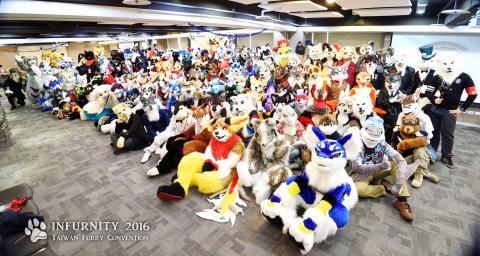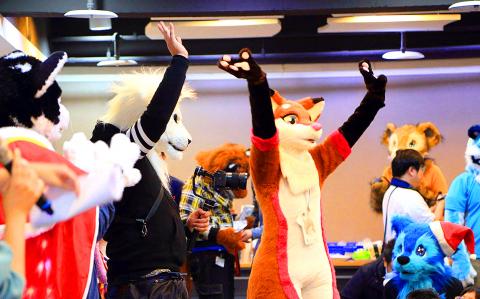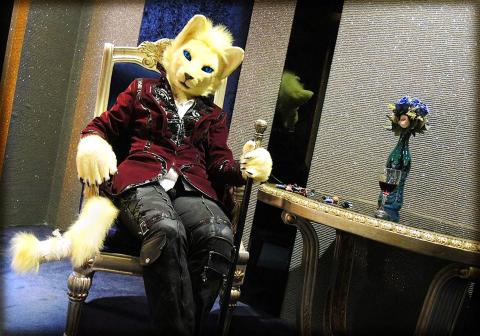Zilven Chang doesn’t need a full moon to transform into a silver-maned wolf-man. Once he puts on his “fursuit,” he loses the ability to speak but assumes a newfound cool-and-collected demeanor.
“When I’m a wolf, I’m still myself,” he says. “It’s just a part that I don’t normally display. But I don’t have to act. It comes naturally once the suit is on.”
Chang is one of about 1,000 “furries” (獸迷) in Taiwan who are fascinated with anthropomorphic animals. Many of them don fursuits and adopt a “fursona,” while others are only interested in creative endeavors such as designing their own characters. Chang does both, as he and fellow furry J.C. Lan run Beast Fantasia (奇獸幻響), a studio that makes a variety of furry products — including an illustrated novel titled The Starry Wolves.

Photo courtesy of Infurnity
This “furry fandom” subculture has only emerged in Taiwan in the past few years. Last month, almost 100 wolves, lions, bears, rabbits and mythical animals attended the second annual “Infurnity” convention organized by Chang, Lan and Gary Pai. The country’s first furry trade show, Furrymosa, is scheduled for May.
BECOMING A FURRY
Even though the phenomenon is relatively new, Lan says he’s had an affinity for anthropomorphic animals since he was a child.

Photo courtesy of Zilven Chang
“I’ve always been a furry,” he says. “I watched animal programs and cartoons. I thought they were so cool. I liked their style. It’s just like how some people like cars and watching sports. It’s a natural instinct — I can’t really explain it.”
Lan was described as cat-like in school, and from this trait he developed his fursona as a majestic yellow feline.
Pai’s fascination began with the mascots he saw when he visited Disneyland as a child.

Photo courtesy of J.C. Lan
“I thought they were adorable and approachable, and I liked how they brought people joy,” he says.
As a result, his fursuits lean toward the cartoonish, cutesy type and he adjusts his personality as such. Like Chang, he believes that he’s not acting.
“It’s just how I would act if I became an adorable animal,” he says. “I don’t even think about it.”

Photo courtesy of infurnity
You can have as many fursonas as you want, but the fursuits are expensive — a decent one can cost up to NT$300,000 Lan says.
There are no set rules, and unlike cosplay, there are no existing characters to model after. Some have the ability to talk, while others only communicate through gestures. Lan says his fursona was originally mute, but as an organizer he found it necessary to start speaking.
Some see their fursonas as extensions or alternate versions of themselves, while others create a separate entity with its own name and backstory. Sometimes people show up at gatherings with just a tail or ears, and that’s okay too.
IN THE REAL WORLD
Chang and Lan exclusively interact with the furry community as their fursonas, and reveal their human identities to only a select few (hence the omission of their Chinese names). Some clues to their furry identity can be found while in human form, as both like to wear shirts with wolves printed on them and have furry accessories on their bags.
Outside of furry gatherings, they only wear their fursuits in public during photo shoots, often scaring the children around them because of how realistic they look.
“I heard one mother say, ‘Don’t be afraid, there’s a person inside,’” Lan says. “That actually upset me because I wanted to be a cat at that moment.”
The ones with cartoonish suits are often received warmly, and some enjoy walking around and taking photos with people. But as furry fandom is still obscure in Taiwan, most people don’t know the true connotation behind the suits.
“People just see our exterior and assume that we’re advertising something as a mascot or shooting a film,” Lan says. “But this is something that goes to the core of who we are.”

In the March 9 edition of the Taipei Times a piece by Ninon Godefroy ran with the headine “The quiet, gentle rhythm of Taiwan.” It started with the line “Taiwan is a small, humble place. There is no Eiffel Tower, no pyramids — no singular attraction that draws the world’s attention.” I laughed out loud at that. This was out of no disrespect for the author or the piece, which made some interesting analogies and good points about how both Din Tai Fung’s and Taiwan Semiconductor Manufacturing Co’s (TSMC, 台積電) meticulous attention to detail and quality are not quite up to

April 21 to April 27 Hsieh Er’s (謝娥) political fortunes were rising fast after she got out of jail and joined the Chinese Nationalist Party (KMT) in December 1945. Not only did she hold key positions in various committees, she was elected the only woman on the Taipei City Council and headed to Nanjing in 1946 as the sole Taiwanese female representative to the National Constituent Assembly. With the support of first lady Soong May-ling (宋美齡), she started the Taipei Women’s Association and Taiwan Provincial Women’s Association, where she

It is one of the more remarkable facts of Taiwan history that it was never occupied or claimed by any of the numerous kingdoms of southern China — Han or otherwise — that lay just across the water from it. None of their brilliant ministers ever discovered that Taiwan was a “core interest” of the state whose annexation was “inevitable.” As Paul Kua notes in an excellent monograph laying out how the Portuguese gave Taiwan the name “Formosa,” the first Europeans to express an interest in occupying Taiwan were the Spanish. Tonio Andrade in his seminal work, How Taiwan Became Chinese,

Mongolian influencer Anudari Daarya looks effortlessly glamorous and carefree in her social media posts — but the classically trained pianist’s road to acceptance as a transgender artist has been anything but easy. She is one of a growing number of Mongolian LGBTQ youth challenging stereotypes and fighting for acceptance through media representation in the socially conservative country. LGBTQ Mongolians often hide their identities from their employers and colleagues for fear of discrimination, with a survey by the non-profit LGBT Centre Mongolia showing that only 20 percent of people felt comfortable coming out at work. Daarya, 25, said she has faced discrimination since she